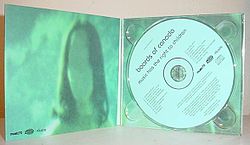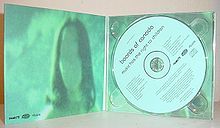- Music Has the Right to Children
-
Music Has the Rights to Children
Studioalbum von Boards of Canada Veröffentlichung 20. April 1998 Label Warp
Skam Records
Matador RecordsFormat CD, LP Genre Elektronische Musik
IDM
Ambient
Trip-HopAnzahl der Titel 17 (Originalversion)
18 (Warp-Wiederveröffentlichung, 2004)Laufzeit 62:58 (Großbritannien)
70:42 (Welt) (Warp-Wiederveröffentlichung, 2004)Produktion Michael Sandison und Marcus Eoin Studio Hexagon Sun Studios, Pentland Hills, Schottland Chronologie Twoism
1998Music Has the Rights to Children Geogaddi
2002Music Has the Right to Children ist das erste Studioalbum des schottischen Elektroduos Boards of Canada. Es wurde von Warp Records am 20. April 1998 in Europa und am 20. August 1998 in den Vereinigten Staaten veröffentlicht. Das Album wurde in den Hexagon Sun-Studios produziert, dem Studio der Band.
Die Lieder auf dem Album nutzen mehrere Feldaufnahmen und intensive Klangmanipulationen.[1] Das Album gilt als erfolgreichstes und von der Kritik am positivsten bewertetes Album des Duos.
Inhaltsverzeichnis
Rezeption
Mark Richardson von Pitchfork Media schreibt 2004: ""Music has the Right" zeigten, dass Boards of Canada genial mit Texturen umgehen. Hier steckt Gott im Detail.[2] [...] "Boards" schafften es, die Kindheit wiederzubeleben, ohne niedlich oder putzig zu wirken. Es ist Kindheit, nicht wie man sie gelebt hat, sondern wie Erwachsene sich an sie erinnern. Die Zwischentöne voller Dunkelheit und ungewisser Spannung [...] reflektieren akkurat die Verwirrung einer Zeit, welche nicht mit einem Gefühl oder einer Emotion aufgerundet werden kann. [3] Richardson gab der Platte 10,0 von 10,0 Punkten, was bei Pitchfork sehr selten vorkommt.
John Bush schreibt bei allmusic: "Das ist der pure Geist der Maschinen. Ähnlich wie vergessene, japanische Soundtracks oder einem rostenden Commodore 64, der kurz davor ist, den Geist aufzugeben. [...] Music has the Right to Children ist eine der besten elektronischen Veröffentlichungen 1998. [4] Bush gab der Platte 5 von 5 Punkten.
Pitchfork platzierte das Album auf Platz #35 der "100 besten Alben der 90er" [5], das "Mojo Magazine" auf Platz #91 der "100 Moderne Klassiker"-Liste. Die Musikzeitschrift NME nahm das Debütalbum in die TOP 25 der psychedelischen Alben auf, auf der sich unter anderem auch Alben der Byrds, der Beatles oder von My Bloody Valentine finden.
Notizen
Mehrere Tracks des Albums bestehen aus Sequenzen, Fragmenten oder kompletten Stücken, welche bereits schon einmal von Boards of Canada veröffentlicht wurden. "Smokes Quantity" erschien erstmals auf dem Album Twoism (1995). "The Color of the Fire" erschien erstmals in einer kürzeren Version auf A Few Old Tunes als "I Love U". Die kurzen Tracks am Ende der Songs "Triangles and Rhombuses" sowie "Sixtyten" sind älter als das restliche Album und wurden später auf der inoffiziellen Kompilation Old Tunes veröffentlicht. Dort sind die Tracks separate Titel.
"Sixtyten" (dt. Sechzigzehn) ist die englische Übersetzung von "Soixante-Dix", dem Wort für Siebzig in der französischen Sprache. 70 ist die kleinste sonderbare Zahl. Ein Track auf ihrem nächsten Album heißt "The Smallest Weird Number" und könnte eine Referenz auf das eigene Musiklabel von Boards Of Canada, music70, sein. "Pete Standing Alone" ist der Name eines Blutindianers, welcher das Thema einer Dokumentation des National Film Board of Canada ist.[6] "Roygbiv" ist ein Mnemo für Farben im sichtbaren Bereich und in Regenbögen: "Roy G. Biv" steht für Red, Orange, Yellow, Green, Blue, Indigo, Violet.
Der Track "Rue the Whirl" erscheint in der Episode "Mettle" der britischen Sitcom Spaced.
Der Track "Kaini Industries" wurde von Bibio für die Warp Records-Kompilation Warp20 (Recreated) (2009) gecovert.
Viele der Samples in den Stücken sind nicht klar zu identifizieren. Der Track "Aquarius" jedoch nutzt ein Sample vom Song Aquarius/Let the Sunshine In von Galt MacDermot. Der Song stammt vom bekannten Musikfilm Hair (1979).
Der Track "Happy Cycling" war fälschlicherweise auf 500 Kopien der ersten US-Veröffentlichung des Albums nicht erhalten, obwohl das Cover der CD den Song in der Titelliste aufführte.
Titelliste
Alle Lieder wurden von Michael Sandison und Marcus Eoin komponiert.
- Wildlife Analysis - 1.17
- An Eagle in Your Mind - 6.23
- The Color of the Fire - 1.45
- Telephasic Workshop - 6.35
- Triangles & Rhombuses - 1.50
- Sixtyten - 5.48
- Turquise Hexagon Sun - 5.07
- Kaini Industries - 0.59
- Bocuma - 1.35
- Roygbiv - 2.31
- Rue the Whirl - 6.39
- Aquarius - 5.58
- Olson - 1.31
- Pete Standing Alone - 6.07
- Smokes Quantity - 3.07
- Open the Light - 4.25
- One Very Important Thought - 1.14
- Bonustrack der Wiederveröffentlichung 2004
- 18. Happy Cycling - 7.51
Weblinks
- Music Has the Right to Children bei Warp Records
- "Roygbiv" bei Warp Records anhören
Einzelnachweise
- ↑ Ariel Kyrou, Jean-Yves Leloup: Two Aesthetes of Electronic Music, 1998
- ↑ Übersetzung vom Autor. Englisches Original: Music Has the Right revealed Boards of Canada to be geniuses with texture, where god is in the details.
- ↑ Übersetzung vom Autor. Englisches Original: Boards managed to evoke childhood without seeming cute or twee. It's childhood not as it's lived but as we grown-ups remember it, at least those of us with less-than-fond recollections. The shades of darkness and undercurrents of tension (qualities which came further to the fore on 2002's Geogaddi) accurately reflect the confusion of a time that cannot be neatly summed up with any one feeling or emotion.
- ↑ Übersetzung vom Autor. Englisches Original: This is pure machine soul, reminiscent of some forgotten Japanese animation soundtrack or a rusting Commodore 64 just about to give up the ghost. [...] Music Has the Right to Children is one of the best electronic releases of 1998.
- ↑ http://pitchfork.com/features/staff-lists/5923-top-100-albums-of-the-1990s/7/
- ↑ http://www.nfb.ca/trouverunfilm/fichefilm.php?id=13730&v=h&lg=en&exp=
Kategorien:- Album (Intelligent Dance Music)
- Album 1998
- Clicks & Cuts
Wikimedia Foundation.


